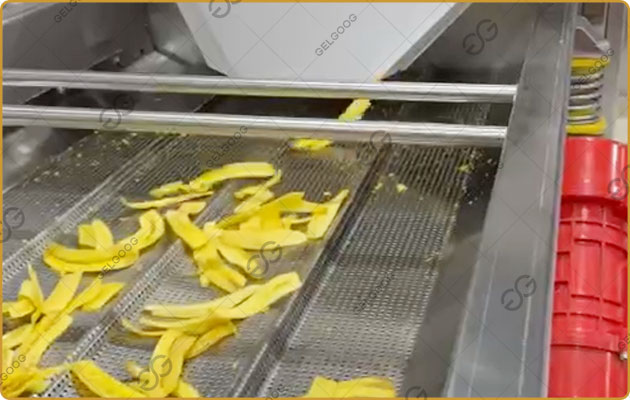Plantain chips, made from plantains, are a popular snack beloved by many for their crispy texture and unique flavor. Below is a detailed introduction to the step-by-step process of producing plantain chips in a factory:
Raw Material Selection
High-quality plantains are the foundation of making delicious plantain chips. Factories typically source green plantains from trusted suppliers and conduct strict quality inspections upon arrival to ensure they meet standards such as appearance, size, and freedom from diseases. Damaged or unripe plantains are eliminated to guarantee the quality of the raw materials.
Washing and Peeling
Selected plantains are first washed in a banana washing machine to remove surface dirt and impurities. Then, specialized peeling machines or manual labor is used to peel the plantains. To ensure product hygiene and quality, the peeling process must be carried out in a sterile environment. Mechanical peeling is more efficient and suitable for mass production.
Slicing
Peeled plantains are fed into a slicing machine, where they are cut into uniformly thin slices. The thickness of the slices is usually between 3-5 millimeters. Uniform slicing ensures even heating during frying and a consistent texture in the final product. Advanced slicing machines can adjust the thickness to meet market demands for different chip textures.
Pretreatment
The sliced plantain chips are soaked in a solution containing salt, sugar, citric acid, or other additives. This step not only enhances the flavor of the chips but also helps preserve them. Some factories also blanch the slices briefly in hot water or steam, followed by rapid cooling. Blanching removes excess starch, improves color retention, and prepares the slices for frying.
Drying
After pretreatment, the plantain slices undergo drying to reduce moisture content. This is crucial for achieving the desired crispiness. The slices are arranged on trays or conveyor belts and subjected to controlled heat. Care is taken to remove moisture without causing excessive browning.
Frying
This is the core step in plantain chip production. Modern factories often use continuous frying equipment, where plantain slices pass through a high-temperature oil tank via a conveyor belt. The frying temperature is typically controlled between 150-180 degrees Celsius, and the frying time is about 2-3 minutes. Precise control of oil temperature and frying time ensures the chips are crispy and not burnt. Alternatively, baking can be used to reduce fat content while retaining crunchiness.

Deoiling
After frying, plantain chips are coated with a layer of oil. Centrifugal deoiling machines are used to shake off excess oil, reducing greasiness and extending shelf life. Some factories also use vibration deoiling machines to quickly remove surface moisture from the slices, ensuring safer and more efficient frying.
Seasoning
Once deoiled, the plantain chips are seasoned based on market preferences. Common seasonings include salt, sugar, honey, chili lime, garlic herbs, and more. Specialized equipment ensures even distribution of seasoning, guaranteeing a consistent flavor across the batch.
Cooling
Fried plantain chips are at a high temperature and need to be quickly cooled to room temperature to maintain their crispiness. Cooling equipment typically uses air cooling, with cold air rapidly removing heat. Cooling time varies depending on the equipment and environmental conditions.
Packaging
Finally, the cooled plantain chips are packaged. Packaging materials are usually food-grade plastic bags or aluminum foil bags with good moisture and oxidation resistance. Automated packaging machines portion the chips by weight into the packaging materials, which are then sealed tightly to prevent air ingress and extend shelf life. During packaging, a sterile environment is maintained to avoid secondary contamination.
Quality Control
Throughout the production process, strict quality control measures are implemented. Modern factories conduct rigorous inspections to ensure plantain chips meet standards for taste, texture, and hygiene. Any batches that fail to meet quality requirements are rejected.
In summary, plantain chip production in a factory involves multiple steps, each of which requires strict quality control to ensure the final product is delicious, safe, and meets market demands. With modernized production processes and equipment, factories can efficiently produce large quantities of high-quality plantain chips to satisfy consumer needs.